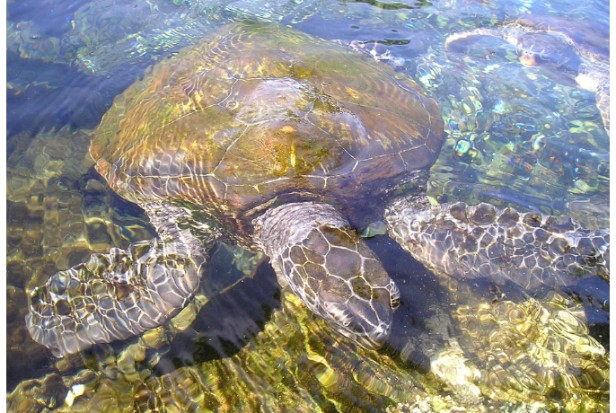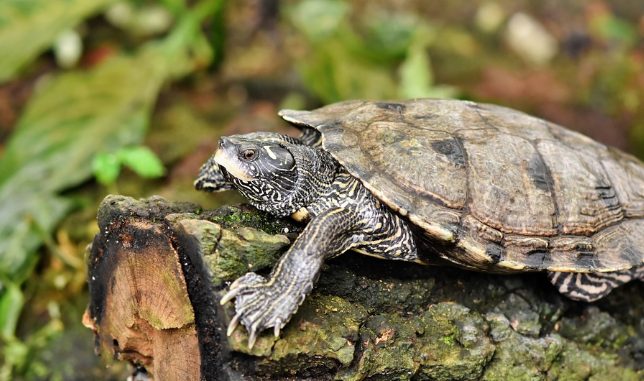
A tortoise cannot swim. They can at most float, drift, and, with any luck, run aground. The majority of tortoise species will sink and drown, but some can swim poorly.
The viral video was helpful, even though it is sad that so many people intentionally kill tortoises in the name of saving baby turtles. It provided some illumination on this unintentionally cruel practice. To clear up the confusion and prevent further tortoise harm, we’ll go into more detail about the subject below.
Why Can Turtles Swim But Tortoises Can’t?
The fact that both animals are reptiles and have remarkably similar looks contributes to the confusion regarding the swimming abilities of tortoises and turtles. It can be challenging for the average person to distinguish between turtles and tortoises because their differences can be so minute.
But why can turtles swim but tortoises cannot, if tortoises and turtles can hardly be distinguished from one another?
Their physiology contains the solution.
Flippers and Feet
The primary physical factor explaining why turtles can swim and tortoises cannot is the distinction between their appendages. Flippers on turtles only have a few tiny claws. In the water, their flippers aid in propulsion.
On the other hand, tortoises have clawed toes and bent legs. They more resemble elephant feet with stumps. These limbs are far better suited to land travel than to water.
You can see that the tortoise’s clawed toes and curved legs are intended to lift the heavy, shelled body significantly higher off the ground when you compare photos of sea turtles and tortoises. However, because of their webbed toes and lack of fins, sea turtles must drag themselves across the ground.
Shell Shapes
Shell weight and shape play a significant role in swimming ability. Turtles have a shell that is flattened, lighter, and more streamlined for slick sea travel. The tortoise, in contrast, has a bulky, domed shell that hinders safe aquatic travel.
Why Do People Get Them Confused?
Because of the tortoise’s location, many people have attempted to save a baby turtle but wound up harming a tortoise. For instance, the gopher tortoise frequently builds its nest in and around the dunes, not far from areas where sea turtles lay their eggs.
Sometimes hatchlings of the two reptiles can be seen together. The young gopher tortoises are simply taking a stroll or basking in the sun, while the young sea turtles are sprinting for the water. Well-meaning people try to “help” by bringing all the hatchlings to the water, without realizing some of them are actually land-dwelling tortoises.

Will a Tortoise Drown in Water?
Yes, a tortoise is likely to drown in the water, and that is the sad truth. Simply put, they aren’t built to swim well, if at all. A tortoise has a very slim chance of surviving an unintentional dip in water, but specific conditions must exist.
A tortoise, for instance, will probably drown if it is dropped into the ocean. A tortoise has a chance of surviving if it is placed gently on top of still water, like in a lake or pond. It only needs to stay afloat and hope that it drifts close enough to land to land and get out.
Can Tortoises Breathe Underwater?
Tortoises lack gills, which prevents them from breathing in water. They are only capable of holding their breath, and some species are better at it than others.
Because they have to expel their air before going inside their shells to hide, tortoises are able to withstand carbon dioxide. As a result, when a tortoise is startled and tries to hide, you’ll frequently hear it exhale.
As previously stated, the leopard tortoise has a 10-minute breath-holding capacity. Numerous tortoises have been protected by this talent, which also prolongs their time spent hidden inside their shells.
In the event that leopard tortoises are submerged and start to float, it has also made it possible for them to survive while attempting to reach land. Additionally, it provided protection for tortoises that were mistaken for turtles and dumped in the water.
Can Tortoises Survive Underwater
The short answer is “no”. While most land-dwelling tortoise species can hold their breath for only a few minutes and will drown if left in deep water for an extended period of time, sea turtles have evolved to be able to hold their breath for up to seven hours.
In order to ensure your pet tortoise’s safety, you should never provide water that is too deep for it to stand up in.
Do Tortoises Float in Water?
The leopard tortoise is one of the species of tortoises that can float. Some tortoises can drift while having their heads above water, according to the Journal of Herpetology.
Because it depends on their age and weight, not all tortoises can do this. Some experts surmise that it has to do with the calmness of the water.
Tortoise species that are lighter than those that are heavier can float much better. Additionally, because their shells aren’t bulky and heavy, young, active tortoises float better.
The tortoise may stay above water if the water is still and the conditions are ideal. It will find it difficult to move, paddle, and avoid hitting a shore. If not, or if the water becomes choppy, it will probably sink.
Do Tortoises Like to Swim?
There’s a good chance that wild tortoises dislike swimming. Since they can’t swim well enough to make it back to land, they tend to stay away from the water. However, they enjoy taking baths, so you might occasionally see one dipping into some shallow water to freshen up.
However, it has been reported that pet tortoises occasionally enjoy bathing in water. It’s crucial to never leave a pet tortoise alone near water for even a brief period of time. A tortoise can flip over, topple over, or have its head submerged in water and drown in a matter of seconds.
Can Baby Tortoises Swim?
Both young tortoises and humans cannot swim. They still might be spotted close to bodies of water, though. Like other animals, baby tortoises need to drink and bathe, but if they are dropped into water or inadvertently fall in, they will likely drown.
A tortoise can hold its breath for a long time, as was previously mentioned. Unfortunately, because young tortoises are not very large, neither are their lungs. A young tortoise couldn’t swim for very long.
Underwater swimming is unusual for tortoises. The occasional video of a tortoise swimming or diving underwater may appear online, but this is not their usual or natural behavior.
Can Tortoises Swim in Pools?
A supervised pet tortoise may enjoy a quick splash in a non-chlorinated pool, but only in the shallow end and not for very long. Be careful not to force a tortoise to remain in the water because not all pet tortoises will enjoy playing in it.
Remember that animals should not be exposed to chlorine. A tortoise should never be kept in a chlorinated pool.
Final Thoughts
The physiology of a tortoise prevents it from swimming, so they are unable to. The tortoise instead floats or drifts in the water. The majority of tortoise species cannot swim well and cannot remain submerged for an extended period of time.
We believe we have covered all the information you require regarding whether or not turtles can swim. In conclusion, turtles and tortoises are two distinct species of creatures that have evolved to live in disparate habitats. In contrast to tortoises, which are land animals and cannot swim, turtles, which live in the ocean, can swim incredibly well.
Despite this, it doesn’t mean that you can’t occasionally give your pet tortoise a bath or that they won’t enjoy soaking in their water bowl.
Just keep in mind never to put your tortoise in danger and abide by our recommendations for a healthy and happy tortoise! Does your tortoise enjoy taking baths? Please tell us in the comments!






